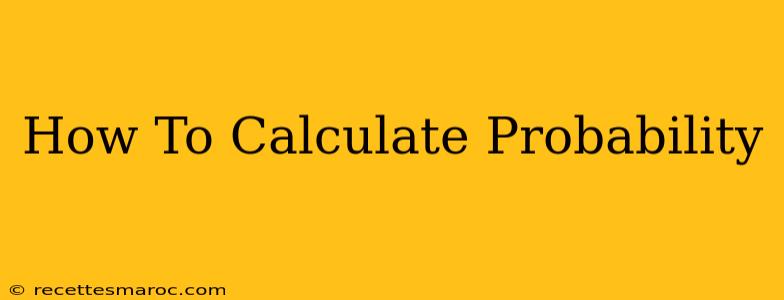Probability is a fascinating field that helps us understand the likelihood of different events occurring. Whether you're a student tackling a statistics problem or someone curious about the chances of winning the lottery, understanding how to calculate probability is a valuable skill. This guide will break down the process, providing you with the tools and knowledge to master probability calculations.
Understanding Basic Probability Concepts
Before diving into calculations, let's establish a strong foundation. Probability is expressed as a number between 0 and 1, inclusive.
- 0: Represents an impossible event. There's no chance it will happen.
- 1: Represents a certain event. It's guaranteed to happen.
- 0.5 (or 50%): Represents an event with an equal chance of happening or not happening.
Key Terms:
- Event: A specific outcome you're interested in. For example, rolling a 6 on a die.
- Sample Space: The set of all possible outcomes. For a six-sided die, the sample space is {1, 2, 3, 4, 5, 6}.
- Favorable Outcomes: The outcomes that satisfy the event you're interested in. For rolling a 6, there's only one favorable outcome.
Calculating Probability: The Formula
The fundamental formula for calculating probability is remarkably simple:
Probability (P) = (Number of Favorable Outcomes) / (Total Number of Possible Outcomes)
Let's illustrate this with examples:
Example 1: Coin Toss
What's the probability of getting heads when you toss a fair coin?
- Favorable Outcomes: 1 (Heads)
- Total Possible Outcomes: 2 (Heads or Tails)
P(Heads) = 1/2 = 0.5 or 50%
Example 2: Rolling a Die
What's the probability of rolling a 3 on a six-sided die?
- Favorable Outcomes: 1 (Rolling a 3)
- Total Possible Outcomes: 6 (1, 2, 3, 4, 5, 6)
P(Rolling a 3) = 1/6
Beyond Simple Probabilities: More Complex Scenarios
While the basic formula is straightforward, probability can become more intricate. Let's explore some common scenarios:
Independent Events
Independent events are those where the outcome of one event doesn't affect the outcome of another. To find the probability of multiple independent events occurring, you multiply their individual probabilities.
Example: What's the probability of flipping heads twice in a row?
P(Heads) = 1/2 P(Heads twice) = (1/2) * (1/2) = 1/4
Dependent Events
Dependent events are those where the outcome of one event does affect the outcome of another. In these cases, you need to adjust the probabilities accordingly after each event.
Example: Drawing two cards from a deck without replacement. The probability of drawing a king on the second draw depends on whether or not a king was drawn on the first draw.
Conditional Probability
Conditional probability addresses the probability of an event happening given that another event has already occurred. It's represented as P(A|B), meaning "the probability of A given B".
Improving Your Probability Skills
Mastering probability requires practice. Work through various problems, starting with simple scenarios and gradually tackling more complex ones. Consider using online resources, textbooks, or educational apps to reinforce your understanding. The more you practice, the more confident you'll become in tackling probability calculations.
Conclusion
Calculating probability is a fundamental skill with applications across many fields. By understanding the basic formula and concepts outlined above, you'll be well-equipped to analyze and predict the likelihood of events, making informed decisions based on probability. Remember, practice is key to mastering this essential mathematical concept.

